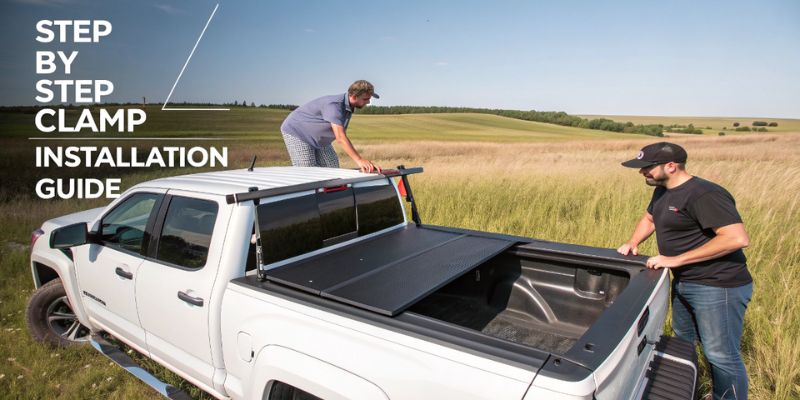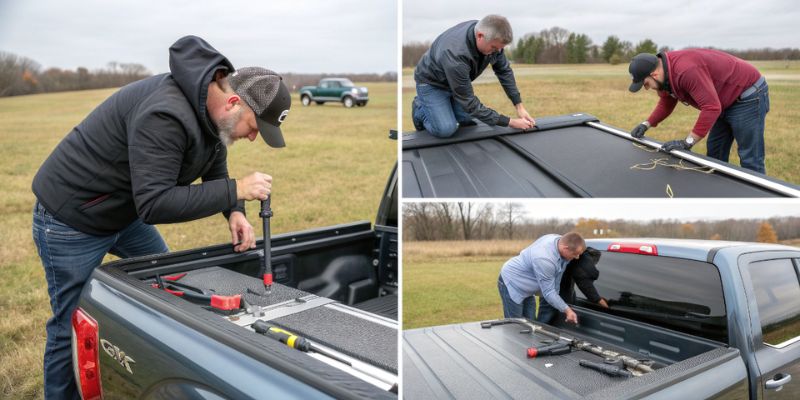Align the tonneau cover with the truck bed. Open clamps, slide into cover’s rail, then onto bed’s flange. Close clamps to secure. Check for even placement and tightness.
Step-by-Step Guide to Installing Tonneau Cover Clamps

Identifying the Correct Type of Clamp for Your Tonneau Cover
Before you begin the installation process, it is crucial to ensure you have the correct type of clamps for your tonneau cover.
Clamps vary in design depending on the make and model of your truck, as well as the brand and style of the tonneau cover.
Consult the manufacturer’s guidelines to identify the recommended clamps.
If you’re uncertain, visiting a local dealer or an automotive parts website can help you find the right match.
Tools Required for Installation
To install tonneau cover clamps, you will need a few basic tools.
Typically, a socket wrench set and a screwdriver are necessary.
Some clamps may require additional tools, so check the installation instructions beforehand.
Gather all tools and keep them within reach for an efficient installation process.
Preparing the Truck Bed for Installation
Before positioning your tonneau cover, ensure that the truck bed is clean and free from debris.
This helps in the proper alignment of the cover and clamps.
Remove any items from the bed and wipe down the surface with a suitable cleaner to ensure a clean workspace.
Positioning the Tonneau Cover on the Truck Bed
Align the tonneau cover with the truck bed, ensuring it is centered and square.
This alignment is crucial for the proper functioning of the cover.
If the cover is not properly aligned, it may not seal correctly, leading to potential issues with weather resistance and security.
Attaching the Clamps to the Cover and Truck Bed
Open the clamps and slide them into the cover’s rail system.
Next, position the clamps onto the truck bed’s side flange.
Be sure not to tighten the clamps yet, as you may need to adjust their placement for optimal fitment.
Adjusting the Placement of the Clamps
Once the clamps are in place, check for even spacing and alignment.
Adjust the clamps as necessary to ensure that they are positioned correctly.
This step is important for balanced support and to prevent stress on any one part of the tonneau cover.
Securing the Clamps Tightly
After adjusting the clamps to their proper positions, secure them tightly using the socket wrench or screwdriver.
It is essential not to over-tighten the clamps, as this can cause damage to the clamps or the tonneau cover itself.
Tighten until they are snug and the cover is secure.
Tips for Ensuring Even Pressure and Alignment
Double-check the pressure and alignment by gently pulling on the cover to ensure it does not slide or move.
If the cover shifts, the clamps may need further adjustment.
An even distribution of pressure is key to maintaining the longevity and functionality of your tonneau cover.
Troubleshooting Common Issues During Installation

Resolving Problems with Clamp Fitment
If the clamps do not fit as expected, double-check the model and type of clamps you have.
They must be compatible with both your truck bed and the tonneau cover model.
If issues persist, consider reaching out to the manufacturer or returning to the dealer for assistance.
Addressing Sliding or Movement of the Cover
Should the cover slide or move after installation, inspect the clamps for proper tightness.
Adjust as necessary, ensuring they are snug but not overly tight.
Verify that the truck bed’s flange is not damaged, as this can affect clamp stability.
Dealing with Over-tightening and Potential Damage
Over-tightening can strip the clamps or deform the cover’s rail system.
If you suspect this has happened, carefully loosen the clamps and inspect for any damage.
Replace damaged parts as needed to prevent further issues.
Solutions for Clamps Not Holding the Cover Down Properly
If the clamps are not holding the cover down securely, re-evaluate their positioning.
Ensure that the cover is correctly aligned with the bed and that the clamps are evenly spaced.
If the problem continues, additional clamps may be required for better support.
Maintenance and Care for Tonneau Cover Clamps

Routine Inspection and Tightening of Clamps
Regularly inspect your clamps to ensure they remain tight and in good condition.
This is especially important after periods of heavy use or exposure to extreme weather. Tighten any loose clamps to maintain security and functionality.
Cleaning and Lubrication Practices for Clamps
Keep the clamps clean by wiping away any dirt or grime that accumulates.
Applying a light lubricant to the clamp mechanisms can prevent rust and ensure smooth operation.
Be sure to use a lubricant appropriate for outdoor and automotive use.
When to Replace Worn or Damaged Clamps
Inspect clamps for signs of wear or damage during your routine checks.
If you notice cracks, corrosion, or other forms of deterioration, replace the clamps immediately.
Using damaged clamps can compromise the security of your tonneau cover.
Seasonal Considerations for Tonneau Cover Clamp Care
Weather changes can affect the functionality of your clamps.
In colder months, make sure the clamps are not frozen before attempting to adjust them.
During summer, check for expansion due to heat and adjust if necessary to maintain a snug fit.
FAQs About Installing Tonneau Cover Clamps
How do you align a tonneau cover with the truck bed before installing clamps?
Align the tonneau cover by positioning it on top of the truck bed, ensuring it is centered and there is an equal distance on all sides between the cover and the bed’s edges.
What is the first step to secure a tonneau cover with clamps?
The first step is to open the clamps on the tonneau cover, then slide them into the cover’s rail system before attaching them onto the bed’s flange.
How do you attach tonneau cover clamps to a truck bed?
Attach the clamps by sliding them into the tonneau cover’s rail and then clamping them down onto the truck bed’s flange to secure the cover in place.
How do you check if a tonneau cover is evenly placed?
After installing the cover, inspect all sides to ensure that it is evenly spaced from the edges of the truck bed and that the cover sits flush along the length and width of the bed.
How can you ensure the tonneau cover clamps are tight enough?
Ensure the clamps are tight enough by pressing them firmly into place and checking for any movement in the cover. Re-tighten if necessary to make sure the cover is securely fastened to the truck bed.
Final Thoughts
Proper installation of tonneau cover clamps is crucial for a secure fit.
Start by aligning the cover with the bed.
Open the clamps, slide them into the cover’s rail and onto the truck bed’s flange. Close the clamps firmly to secure the cover.
Ensure the placement is even and the clamps are tight for optimal performance and protection.
